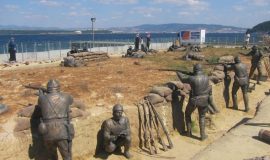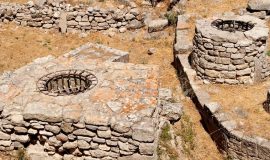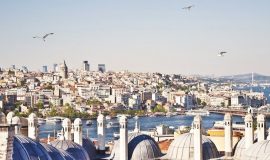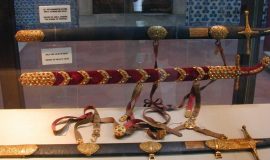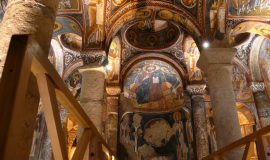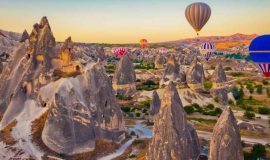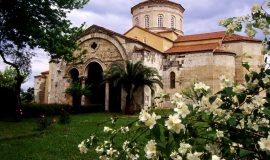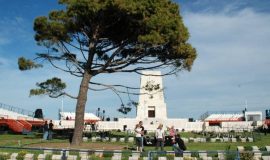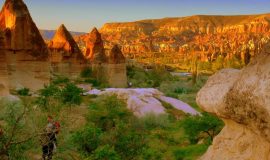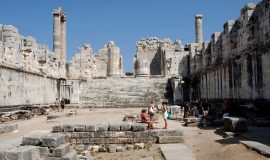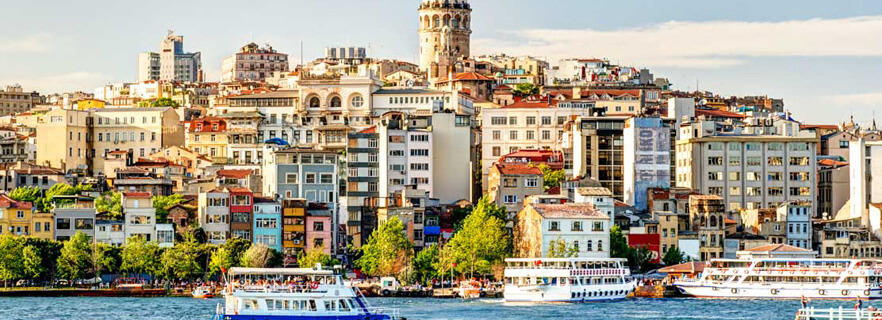
Istanbul
Istanbul is Turkey's most populous and economically most important city. The world's 34th largest economy is the city with the highest population in Europe, according to the ranking made by taking municipal boundaries into consideration.
Istanbul is located in the north-west of Turkey, along the Marmara coast and along the Bosphorus, to surround the Golden Horn.
Istanbul is an intercontinental city, the European side is called the European Side or the Rumeli Side, and the Asian Side is called the Anatolian Side. The western border of Istanbul, which was first established on the peninsula of Marmara Sea, Bosphorus and Golden Horn, which was originally built on three sides in the history, was the Istanbul Walls. In the process of development and growth, the city has 39 cities, which are enlarged 4 times by constructing the city walls by moving them to the west each time. There are a total of 40 municipalities within the boundaries of the metropolitan municipality.
One of the oldest cities in the world, Istanbul, M.S. The Roman Empire between 330 and 395, the Eastern Roman Empire between 395 and 1204 and 1261 and 1453, the Latin Empire between 1204 and 1261 and finally the Ottoman Empire between 1453 and 1922. In addition, from 1517, when the caliphate passed through the Ottoman Empire, until 1924 when it was abolished, Istanbul became the center of Islam.
Etymology
Istanbul has been given different names throughout the ages. These city names are associated with different periods of city history. These names are historically named Byzantion, Augusta Antonina, Nova Roma, Constantinople, Constantinople and today's Istanbul names.
Byzantion: Byzantion (Greek: Βυζάντιον, Latin: Byzantium) is the first known name of Istanbul. B.C. In 667 the Doric Greek settlers from the Megara city state in ancient Greece set up a colony on present-day Istanbul and named it Byzantion in honor of Byzas or Byzantas (Greek: Βύζας or Βύζαντας) of the new colonial kings.
Byzantium, the original name of the ancient city Byzantion M.S. In the 1st century, when the city was conquered by the Romans, it was a latinceleised by them.
Augusta Antonina: Augusta Antonina is the short name of the city that Istanbul put in honor of his son Antonius (next Roman Emperor Caracalla) by the Roman Emperor Septimius Severus at the beginning of the 3rd century.
Nova Roma: M.S. When the city of Rome was declared the capital of the Roman Empire by the Roman Emperor Constantine I in 330, he put the name of Nova Roma (Greek: Νέα Ρώμη, Nea Roma), which means "New Rome" in the city, and never tried to promote this name.
Constantinopolis: But M.S. In 337, the name of the city of Emperor Constantine I died, and in honor of him, Constantinople (Greek: Κωνσταντινούπολις, Kōnstantinoúpolis, Latincianized: Constantinopolis), which means "the city of Constantine". Constantinople remained the official name of the city during the Eastern Roman (Byzantine) Empire. But Constantinople was referred to by the city's inhabitants as the only Greek "city" (Πόλιν, Polis).
Even after the conquest of Ottoman Sultan Mehmed II in 1453 by the Ottoman Empire, Constantinople remained the most common name used in the West. Even after the foundation of the Republic of Turkey on October 29, 1923, the name of Constantinople continued to be used by Westerners for almost the first 7 years of the Republic.
Konstantiniyye: Constantinople (Arabic: القسطنطينية, al-Qusṭanṭiniyah, Ottoman Turkish: قسطنطينيه, Constantinople) is the Arabic form of Constantinople and became the most widely used name in the city's Islamic world. Contrary to Constantinople, which means "the city of Constantine" in Greek, Constantine means "place of Constantine" in Arabic.
After the conquest in 1453, the city was declared the fourth capital of the Ottoman Empire, and Constantinople was used by the Ottoman state as the official name of the city, and until 1923 the Ottoman Empire collapsed. For example, titles such as "Be-Makam-i Darü's-Saltanat-ı Kostantiniyyetü'l-Mahruşâtü'l-Mahmiyye" were used in order to indicate the origin of the official documents published in Constantinople in the Ottoman state and courts.
However, in some periods the Ottoman authorities were from other names for the city. Especially for the city and for the diplomatic correspondence to define the Ottoman government, these glorious names were used synonymously and encouraged:
Dersaadet (Arabic: در سعادت, "Happiness Gate")
Derâliye (Arabic: در عاليه, "The Great Gate")
Bab-i Âli (Arabic: باب عالی, "The Great Gate")
Pâyitaht (Persian: پایتخت, "Throne of the Foot" or "Capital")
Acidane (Persian: آستانه, "The State's Threshold")
Istanbul: Etymologically, the root of the name of Istanbul (Turkish pronunciation: [istanbuɫ]), and sometimes [ɯstambuɫ] among the locals, means "in the city" or "in the city" in the Middle Ages (Byzantine) Τὴν Πόλιν], [isin polin]) was formed by Turkishization of the words.
The name of Istanbul has been in Arab sources since the 10th century (in different forms) and in Turkish sources since the 11th century. Also, the name of Istanbul was used in Turkish before the 1453 conquest, especially for the Turkish people among the Turkish people.
In the Ottoman Empire, in the first periodical documents [18], the name of Istanbul is called Ottoman Turkish (استان, a-sitan or i-stan), and it means i-stan "beauties" in Arabic. In his recent documents (استانبول, a-stan-bol or i-stan-bul).
Although Istanbul was not an official name in the Ottoman period, it entered official documents and was frequently used. In addition, for the central army commander of Istanbul in the Ottoman Army, officially the Istanbul branch and officially the title of Istanbul master for the highest civilian judge of Istanbul were used. This adjective later became prestigious and began to be used informally for cultured and mysterious Istanbulites.
Even after the establishment of the Republic of Turkey on October 29, 1923, the names of Constantinople continued to be used by Constantinople for almost the first 7 years of the Republic and by Westerners abroad.
However, on March 28, 1930, the name of the city was officially changed with the Turkish Postal Service Law and it was named Istanbul. The name Constantinopolis (and Constantinople) was completely abolished. Moreover, the Turkish authorities demanded that the name of Istanbul be used as the only name of the city in foreign languages from foreigners and put it into practice. After the declaration of the official and international name of the city of Istanbul together with the Republican period, it was forbidden to use the name "Constantinople" in letters or other correspondence and internationally. For example, if the letters sent from abroad to Istanbul were written as "Konstantinopolis" (even if you wrote it in Istanbul) as addresses, these letters began to be sent back.
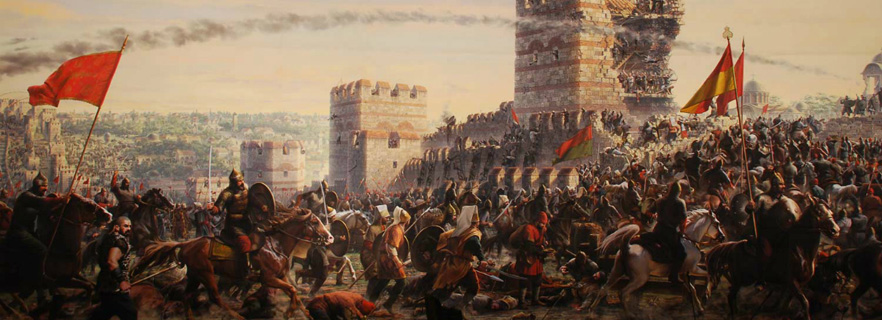
History
General history: Istanbul is a world city with settlement history of 300 thousand, urban history of about 3 thousand, capital city date of 1600 years and Europe and Asian continents. The city has been home to different civilizations and cultures throughout the ages and has been a unique mosaic in the historical process, preserving the cosmopolitan and metropolitan structure where various religions, languages and racial people lived together for centuries. One of the few places in the world that has managed to remain central and central to all areas for long periods of time, Istanbul is a world capital of the past.
Prehistoric ages: The history of Istanbul dates back to three hundred thousand years ago. The excavations in the Yarımburgaz cave on the edge of Küçükçekmece Lake were the first to see human cultures. Neolithic and Chalcolithic people are believed to live in this period around the lake. Excavations in various periods revealed the Lower Paleolithic Age near Dudullu and the Middle Palaeolithic and Upper Palaeolithic ages in the vicinity of Ağaçlı.
Establishment period and Byzantion: During the excavations made in Fikirtepe on the Anatolian side of the city, where the remains of the Polished Stone Age during the excavations of the Marmaray tube passage made for the Istanbul metro in 2008 were found to be around 6500 BC, Remains dating back to 3500 were found. In addition, remains of Phoenicians were found in Kadıköy. The hills founded Semistra city near the city in the 13th century BC and the 11th century BC. At the time of King Lygos, an acropolis was established in Sarayburnu, where today's Topkapi Palace is located. Greeks from Megara in 685 BC set up a colony here, Byzantion was established in 667 BC, when King Byzas ruled. When the city was dominated by the Roman Empire, the name of the city was given by Septimius Severus to his son Augusta Antonina for a brief period, and then in the time of Emperor Constantine I, the city was declared the capital of the Roman Empire. At the same time, the name of the city changed to Nova Roma, and in 337 Emperor Constantine I was converted to Constantinople.
The Byzantine Empire Period: This period included between 324 and 1453 BC. After Constantine I conquered the city and made it the capital of the Roman Empire, the city became the administrative center of the east of Rome. The Roman population increased significantly in this period, including the migration of Roman nobility. In this period; The city has expanded considerably with a new architecture. A hippodrome of 100,000 people (Sultanahmet Square) as well as ports and water facilities were built.
During the period of Constantinus the city was named Nova Roma dese; On May 11, 330 the name of the city became Constantinople. Constantine, who founded Hagia Sophia, the world's largest cathedral in 360, And thus changed the religion of the Roman Empire to Christianity. The first break with the western belief in Pagan Roman religion began in this period. Although, Beginning with the death of the Byzantine Empire I. Theodosius; The Byzantine Empire Constantine regarded him as a Byzantine emperor because of his respect for Christianity; Until the collapse in 1453, the 10 Emperors became the more famous Constantine. The role of Istanbul in this period was quite strategic; It was a gate between Europe and Asia. On this occasion, it was a center for trade, culture and diplomacy. In this period, the name of the city was "Poli" (city).
After the collapse of Western Rome in 476; A large majority of the Romans in the Western Roman Empire migrated here, and the capital of the Byzantine Empire became Istanbul. After the plague epidemic, which caused the death of half the population in 543; The city was rebuilt during the reign of Emperor Justinian I. The city was attacked by Sasan and Avarlar in 700 years; In 800 years, Bulgarians and Arabs were attacked by Russians and Bulgarians in 900 years.
But; The most devastating among the attacks was in 1204. By the Crusaders; 4. The city seized in the Crusade in 1204 was looted; A large majority of the population fled from the city; Poor and transformed into a city in wreckage. That is why the Latins growing in Western Rome; The differences between the Catholic Christianity and the Orthodox Christianity belief in Byzantium are mismatches. After this period, in 1261 Palailogos Dynasty; Michael VIII Palaeologus recaptured the city and concluded the Latin period.
After this period, Byzantine was gradually shrinking; It was begun to be besieged by the Ottoman Empire after 1391; Eventually passed on to the Ottoman Empire in 29 May 1453. The conquest of Istanbul symbolizes the end of the Middle Ages in the history of the world.
Constantine, the last emperor of Byzantium, defended Istanbul well before the conquest. Grejvar, which burned even when it was burning, made sea cruises difficult. The strength of the Turks made 70-80% more difficult to enter the city.
Ottoman Empire period: This period included between 1453 and 1923. On 29 May 1453; After the siege of Fatih Sultan Mehmet, the sultan of the Ottoman Empire for 53 days; Istanbul was the third and last capital of the Ottoman Empire.
After the capture of the Ottomans; After the establishment of Topkapi Palace and Grand Bazaar, many schools and baths were opened. It was a cosmopolitan society where Jews, Christians, and Muslims lived together in the city where people from all over the world and the Empire moved. Old buildings and fortifications from the Byzantine period were repaired. [33] 50 years after the conquest; In Istanbul, which has become one of the biggest cities in the world, it is called "Little Doomsday" 14 September 1509 Istanbul After the earthquake (claimed to be 8 magnitude); Thousands of buildings were destroyed by 45 days of aftershocks, and many people lost their lives.
In 1510; Sultan II. Beyazid; 80,000 people have rebuilt the city with the work. A great majority of the works still exist today. During the reign of Süleyman the Magnificent, who built the monuments and other buildings of the architect Sinan; Architecture and art. During the Tulip Revolution; Grand Vizier Nevşehirli Damat İbrahim Paşa Since 1718; Established the fire department, opened the first printing house and built factories. After the Tanzimat Fermanı which was announced on 3 November 1839, westernization process was accelerated and many innovations took place.
Bridge over the
Golden Horn; Istanbul, which has become a modern city with the construction of tunnels, railways, sea transportation within the city, municipal organizations and hospitals to Karaköy, was severely damaged again with the Üçyüzon Earthquake in 1894. In the end of World War I, on November 13, 1918, the Entente States navy was also occupied. Istanbul's 2500-year-old capital city ended on October 29, 1923.
In the Ottoman and Byzantine records, the siege of Istanbul in the year of Yıldırım Bayezid was abolished in 1402. 760 houses from Göynük and Tarakli were placed in Manav Istanbul in accordance with the agreement to establish a Turkish neighborhood in Sirkeci. In other words, it is also confirmed that the first indigenous Turks who were settled in Istanbul were the Groceries from this region. Especially the origin of the Turks on the Anatolian side is the groceries.
The Republican period: "If the world was a single country, the capital would be Istanbul." Napoleon Bonapart
Between the years of 1923-1950 after the Republic was physical breakthroughs. The population of 1 million at the beginning of the 1900s fell to 690,000 in 1927, 740,000 in 1935, and again reached 900,000 in 1945. In the city that migrated from the Balkans in the 1950s, the cityscape has a slippery front. In the 1960s, apartment building started near the slums. In the 1970s, rapid population growth and housing and transportation problems gained importance. The increase in the number of cars and the increase in traffic as a result of this period was effective in the construction of the Bosphorus Bridge and an important point in transport was reached. The metropolitan area of Istanbul reached a radius of 60 kilometers in 1980 while it was 50 kilometers in the center between 1970-1975. Population growth in the 1990s resulted in the population spreading abroad, and as a result, the IETT was inadequate and minibuses tried to close the gap. The Bosphorus Bridge was opened in 1973 in the city, where the reconstruction activities were revived, though not with the old pace in the 70's.
Art: Since the city has changed hands and worn many times, there are not many buildings belonging to the Roman Empire period. The most important ones in the remains: the monument erected in 330 in honor of Emperor Constantine I, one of the seven hills of the city. The column was formed by stacking a total of 8 columns and a column on top of each other, each of which weighs 3 tons and is connected by 3-meter-diameter bracelets. Bozdoğan Kemeri is another structure that has remained daily from this period. The construction of the city's water reserve system began during the reign of Emperor Hadrian. In the time of Constantine I, the city had to be further expanded in order to meet the rapidly growing population need with the restructuring and growth of the city. Kemer took its place from the hillsides of the hills between Kağıthane and Marmara Sea and from the hilly regions of Thrace to the city and was at the last point of the wide arches and channels system that met the water need of the city. This water that came to the city at that time was stored in more than one hundred underground cisterns such as three open and Yerebatan Cisterns with a total capacity of more than 1 million cubic meters. Hipodrum Square, now known as Sultanahmet Square, was built by Circus Maximus.
The Eastern Roman Empire: The Maiden's Tower was the only work left in the Byzantine Empire in
Üsküdar.
The Eastern Roman Empire ruled the city for a thousand years and used it as the capital. Because of this feature, there are many Eastern Roman structures in Istanbul. The most important of these are gathered in Eminönü. The most important of these structures is the
Hagia Sophia Museum, which opened as a church. Haghia Sophia is the first Roman Emperor of the Roman Empire. It is a basilica-planned patriarchal cathedral built between 532 and 537. It was transformed into a gallery by Fatih Sultan Mehmet when it was conquered by Turks in 1453 and today it serves as a museum.
One of the important structures built after Hagia Sophia was the Fethiye Mosque. It was built as a church by Mihail Glabas Tarkaniotes, one of the elders of Eastern Rome, in the late 13th century. After the conquest of Istanbul, it was used as a patriarchate in 1454, and in 1590 it was transformed into a monument to the conquest of Georgia and Azerbaijan by the conquest of Iran. Another important building, the Kariye Museum, was built by St. Theodius in 534 as a monastery during the reign of the First Roman Emperor Justinian. In the 11th century, the mother-in-law of the first Aleksios was rebuilt by Maria Doukaina. The monastery, which was destroyed during the Latin Empire period of 1204-1261, was repaired by Theodoros Metokhites in the 14th century. External narthex and parekklesion were added to the structure during this period.
Ottoman Empire: Art in the Ottoman Empire is very advanced as an architect. Numerous works were made during the Imperial period. The construction is so dignified and majestic that it is simple and useful. The magnificent palace type came in from the West in the 19th century. However, the glass and the Tekkel made in the name of Allah are utterly abidevil. The glassy terraces are built with many social institutions and constitute a "complex". The Ottomans are extraordinary imams. Even if constructs do not belong to their civilization, keep them with care. One of the best examples of this is the Church of St. Irene. There are no empire corners that can not be seen. Even some modest neighborhood riches can not make a mosque if they make a fountain or repair a school. The sense of community is extraordinarily strong. There is an alliance when architect Sinan is one of the greatest architects of world history, perhaps the first. Sinan, who lived for a century and spent the last half century as architect, has made these works. There are 81 mosques, 50 mosques, 55 madrasa, 19 tombs, 14 imarets, 3 hospitals, 7 water houses (dams), 8 bridges, 16 caravanserai, 33 palaces, 32 baths, 6 cellars, 7 d'arulkurra. These 441 works were scattered throughout the empire. In 1839, the declaration of the Tanzimat Fermanı took important steps towards Europeanization. The Ottomans adopted the European style towards the end of the 18th century and reflected it in architecture and art. Baroque style spreading in Europe is also suitable for making many works in Istanbul. Dolmabahçe Palace, Beylerbeyi Palace and
Ortaköy Mosque, which are built in baroque and rococo style, constitute an important place for this kind in the world.
Geography: Istanbul is located at 41 ° K, 29 ° D coordinates. The Çatalca Peninsula in the west and the Kocaeli Peninsula in the east. The city consists of the Black Sea in the north, the Marmara Sea in the south and the Bosphorus in the middle, the Saray connected to Tekirdağ in the north, the Çerkezköy, Tekirdağ, Corlu, Tekirdağ, Tekirdag, and Marmara Ereğlisi connected to Tekirdağ in the west, The Gulf bound to Kocaeli in the east, and the Gebze districts connected to Kocaeli in the south. Çatalca Europe and Kocaeli are the main pillars of Istanbul. The Bosphorus in the middle of the city combines these two continents. Fatih Sultan Mehmet and Bosphorus Bridges on the Bosphorus connect the two sides of the city. It was built along the Bosphorus and around the Golden Horn in the north of Turkey.
Geology: The North Anatolian Fault Line, located near Istanbul, extends from North Anatolia to the Sea of Marmara. Two tectonic plates, Eurasia and Africa, push each other and cause the fault to move. Due to this fault line, there have been very severe earthquakes throughout the history of the region. The Great Istanbul Earthquake that took place in 1509 is the biggest example of this. This earthquake has caused the destruction of 100 mosques in Istanbul and the loss of 10 thousand people's lives. In the earthquake of 1766, structures such as Topkapi Palace, Hagia Sophia, Eyüp Sultan Mosque and Grand Bazaar suffered great damage. In the 1999 Gölcük Earthquake, 18 thousand people died and many people were homeless. Seismologists state that they may be in an earthquake of size 7 before 2025.
Climate: İstanbul's climate is a climate that shows the transition between the Black Sea climate and the Mediterranean climate, so Istanbul's climate is moderate.
The summers of Istanbul are hot and humid; Winters are cold, rainy and sometimes snowy. Because of humidity, the air is warmer than it is hot; It may feel colder than it is cold. The average temperature in winter is around 2 ° C to 9 ° C, and rain and rain mixed with rain are often seen. Snow also falls. In the winter months it can snow for a couple of weeks. The average temperature in summer is around 18 ° C to 28 ° C and rain and flooding are common.
The hottest months are July and August, the average temperature is 23 ° C, the coldest months are January and February, and the average temperature is 5 ° C. The average temperature in Istanbul is 13.7 degrees.
The total annual precipitation is 843.9 mm and is observed throughout the year. 38% of the precipitation is in winter, 18% in spring, 13% in summer and 31% in autumn. Summer is the driest season, but unlike Mediterranean climates, there is no dry season. Istanbul has suffered from thirst until 1994 but there is no water problem with the measure taken.
The highest air temperature so far; Was recorded at 40.5 ° C on July 12, 2000. The lowest air temperature is; On February 9, 1929, it was recorded as -16.1 ° C.
Natural Life: There are about 2500 plant species such as boxwood, oak, plane, beech, hornbeam, maple, chestnut, pine, spruce and cypress in İstabul region which has a very rich plant community. Some of these plants are endemic to this locality. The trees that make up the forests generally are the beech, chestnut and stemed meadows seen around the northern part of Istanbul, the north of Alemdağ and around Polenezköy. In addition to the effect of climate on plant cover, there is an effect on the soil. While the areas where the beech tree community is located are covered with untreated brown forest soils, in the oak and chestnut community these are lime-free. Having around 2500 natural plant species, Istanbul is able to leave European countries such as England alone with this feature. This means that about one-fourth of the more than ten plants naturally grown in Turkey are to be sheltered in Istanbul; And some of these plants are endemic, ie they live only in Istanbul on the whole world.
Being rich in terms of animal life, rare mammals such as deer, wild boar, wild cat, wolf, jackal, lynx, bear and fox can be found in Istanbul. However, Istanbul, which is located on an important bird migration route, can observe various bird species such as storks, eagles, falcons and hawks every spring and autumn. The most common birds in Istanbul are sparrows, doves, doves, crows and martins, which have now become a symbol of the city.
City Panaroma: Istanbul has a total of 39 counties. 25 of these districts are on the European side and 14 are on the Anatolian side. The cities of Istanbul are divided into three main regions:
Fatih and Eminönü, the historic peninsula of Old Istanbul (Eminönü is bound to the Fatih district by a law in 2008. Today the peninsula forms the Fatih district). The Golden Horn is located on the northern shores of this region. It stretches as far as the Istanbul Walls in the West. The southern border is the Sea of Marmara. In the east there is the entrance of the Bosphorus.
The districts of Beyoğlu and Besiktas in the north of the Golden Horn have a great history in terms of history. The palace of the last Ottoman Sultans is at the Dolmabahçe Palace in Kabatas. Along the banks of the Bosphorus, old neighborhoods such as Ortaköy and Bebek follow each other. On both sides of the city there are luxurious boats that continue along the Bosphorus.
Üsküdar (ancient Chrysopolis) and Kadıköy (antique Chalcedon) districts were changed in time from old cities to cities and they became the cities of Istanbul. It is the oldest districts of Istanbul on the Anatolian side. Today, many contemporary settlements and business districts have great precaution. The city is home to a third of its population.
A great differentiation is seen from the historical districts of Istanbul to the west and north. While the highest skyscrapers and office buildings are located on the European side especially in Levent, Mecidiyeköy and Maslak, on the Anatolian side the Kozyatağı neighborhood in Kadıköy district attracts attention. The rapid growth of the city in the 20th century caused a great migration to the east and west. Thus, the city's gecekondurma has gained a great speed. These buildings, built as escape treasures or private terrains, are made in a short time and at low quality. These buildings are widespread in Ankara and Izmir which are among the biggest cities of Turkey. Gecekondular causes a great deal of urbanization.
Urbanization: Istanbul's city structure and shape are constantly changing. During the Greek, Roman and Byzantine periods, there was a significant revival and growth in the historical peninsula of Constantinople, in Galata (Pera, later Beyoglu), Chalcedon (Kadıköy) and Chrysopolis (Uskudar). In ancient times, all the cities of Istanbul were independent cities. Today, Istanbul can be regarded as the metropolis of old Constantinople. Because the city has been expanding and renewing since then.
The very high buildings built in recent years have been made considering the rapid growth of the population. Because of the rapid expansion of the city, housing is usually moving out of the city. The highest multi-storey office and dwellings that the city has had were gathered in the Levent, Mecidiyeköy and Maslak districts on the European side. Levent and Etiler have a large number of shopping centers. A significant portion of Turkey's largest companies and banks are located in this region.
Since the second half of the 20th century, especially on the Anatolian side, the speed of the construction of summer houses and luxurious mansions near the sea has been accelerated. Bagdat Caddesi in the district of Kadıköy has many shopping centers and restaurants in its length and width. These developments have contributed positively to the development of the region. The collar is the migration from Anatolia, the biggest factor of the population growth that took place in recent years. Today, 66% of Istanbul's people live on the European side.
Administration: Kadir Topbaş is the Mayor who is still in office in Istanbul. The governor of the city is Hüseyin Avni Mutlu.
Istanbul is governed by presidents who lead the party system. This management style has been going on since April 3, 1930, when the Istanbul Metropolitan Municipality was established. The municipality holds all the decision-making power of the city. The city administration has been gathered in three main bodies. 1. Mayor (elected every 5 years) 2. Metropolitan Council, 3. Metropolitan Board of Directors.
Today Istanbul Metropolitan Municipality Building is located in the area known as Fatih district of Saraçhane. The building was completed on December 17, 1953 and began to serve on May 26, 1960 as a municipal building.
Religion: Istanbul is shaped by many people like most metropolises in the world. The religion with the greatest number of people in the city is Islam. Religious minorities are Greek Orthodox Church, Armenian Apostolic Church, Sephardic and Ashkenazi Jews. According to the 2000 census; 2,691 active mosques, 123 active churches, 26 active synagogues. There are also 109 Muslims and 57 non-Muslim cemeteries. These religious minorities lived in certain districts before their numbers were much diminished. For example, Kumkapi had an Armenian population, Balat had a Jewish population, and Fener had a Greek population. The spiritual leader of the Greek Orthodox Patriarchate, I. Bartholomeos, is located in the Fener district of Fatih. This patriarchate is the center of the Orthodox sect that constitutes an important part of the Christian religion.
It is a view from the inner courtyard of Sultan Ahmet Mosque, one of the most important mosques in Istanbul.
Muslims: The city's largest religious group is Muslims. Apart from these, the Sunnis, the most crowded sect form of Muslims, are the more populous Alevis following this denomination. According to the number in 2007, the total number of mosques in the city is 2,994. Istanbul was the last center of the Islamic Caliphate. The caliphate, which started with Yavuz Sultan Selim in 1517, ended with Abdulmecit on March 3, 1924. On 2 September 1925 the tekkeler was closed and the order was banned. Thus, the secular system in the country has started and Istanbul, which is the most affected by this change, has been Istanbul. Immediately after the removal of the Halif al-Diyanet, the Presidency of Religious Affairs was established. The Sheikhulislams, who had the highest authority in the Ottoman Empire, also left their place to the Director of Religious Affairs.
Christians: The city has been the center of the Greek Orthodox Patriarchate since the 4th century and continues to serve centrally in other Orthodox churches. At the same time, the city is the center of the Turkish Orthodox Patriarchate and the Istanbul Armenian Patriarchate. In the past years, when the Bulgarian Piskops were on the frontline, this time they left their place to Orthodox Churches. Especially the Greeks and Armenians who lived in Istanbul experienced conflicts with the Turks from time to time during the collapse of the Ottoman Empire, but the order was restored by the establishment of the Republic of Turkey. Between 1914 and 1927, the Christian population in the city fell rapidly from 450,000 to 240,000 due to wars. Greek Orthodox society living in Istanbul was exempted from Turkey-Greece Population Exchange in 1923. However, during the Second World War a number of taxes were introduced for this minority. (See Asset Tax) The events of September 6-7, which were the destruction and pillage of the Greek minorities that took place in 1955, killed 11 Greeks and injured 30 to 300 people. As a result, immigration has increased rapidly from Istanbul to Greece and has been removed from 12,000 Greek citizenship.
Along with the conquest of Istanbul, many churches have been turned into mosques. The biggest and most important of these mosques is Hagia Sophia in the Eminönü district of Fatih. At the request of Hagia Sophia Atatürk, the worship was closed and with the approval of the Council of Ministers, it started to serve as a museum on November 24, 1934. In addition, after the conquest of the old structures such as Fenari İsa Mosque, Arap Mosque, Kocamustafapaşa Sümbül Efendi Mosque, the mosque is converted into a mosque.
The inside view of the Neve Shalom Synagogue, which has the most important place in Istanbul.
Jews: Sephardic Jews are living in this city, which is over 500 years old. The population of Jews in Istanbul today is around 22,000. Ashkenazi Jews are a relatively new and much smaller community of Sephardic Jews. The Jewish worshipers are synagogues. The number of active synagogues in the city is 20. Neve Şalom Synagogue, located in the Karaköy district of Beyoğlu district, is the biggest carrier among these synagogues. The synagogue, which was opened in 1951, has the largest community. The language of the Sephardic Jews, the Ladino language (Jewish Spanish), is spoken by people over the age of 65, even if understood by Jews under the age of 65, is no longer spoken. Ladino is therefore faced with a serious threat of extinction.
Economy
Istanbul is Turkey's largest city and politically former capital. It has become a center of economic life in Turkey due to its strategic position and being a junction of land and sea trade routes. The city is also the largest industrial center. It covers 20% of industrial employment in Turkey. It has about 38% industrial area. Istanbul and the surrounding areas are in this area; Fruit, olive oil, silk, cotton and tobacco. It is also one of the important industrial products of the city in the food industry, textile production, petroleum products, rubber, metal goods, leather, chemistry, medicine, electronics, glass, technological products, machinery, automotive, transportation vehicles, paper and paper products and alcoholic drinks . According to a study by Forbes magazine, as of March 2008, the city with 35 billion was the fourth in the world rankings. The Dersaadet Bond Stock Exchange, which was first opened in Istanbul in 1866, was changed to the current Istanbul Stock Exchange (ISE) in early 1986 and the present Istanbul Stock Exchange (ISE) was opened. Located at the Galata district in the early 19th and early 20th centuries, Bankalar Caddesi became a financial center for the Ottoman Empire. In this region, the central bank of the Ottoman Empire Bank-ı Osmanî (after 1856, reorganized and Bank-ı Osmanî-i Shahane since 1863) and the Ottoman Stock Exchange were found. Bankalar Caddesi, being a financial and economic center until 1990, has become a center of modern business centers Levent and Maslak as a result of the beginning of the renewal movement. In 1995, the Istanbul Stock Exchange moved to its present-day building in the İstinye district of Sarıyer.
Today, Istanbul has 55% production of Turkey and 45% of trade volume. It accounts for 21.2% of the Gross National Product in the country. In 2005, the gross domestic product reached 133 billion dollars. According to the data of 2005, the number of exports made by companies based in Istanbul was 941,397,000,000 dollars. If it is worth $ 9,883,000,000, import is done.
Tourism
It is one of the most popular tourist centers in Istanbul due to its history, monuments and artifacts, and its ownership of the Bosphorus. According to statistics of 2000 Municipality of Istanbul, two million tourists came to the city. The biggest share among tourists is German with 208,000 people. Germans follow American, British, French and Russians. In 2006, 5 million 346 thousand tourists came to town. This number is about half a million more than the number of tourists in 2005.
Public services
Education: There are thirty one universities in Istanbul, including twenty-four state foundation. Particularly publicly owned educational institutions are among the most respected and well-equipped universities in the country. However, in recent years there has been an increase in the number of private universities. Two of Turkey's three oldest state universities are in Istanbul. Istanbul University was founded in 1453 and is the oldest university in Turkey. Istanbul Technical University (1773) is the world's oldest third technical university and is dedicated entirely to engineering sciences. Other state universities recognized in Istanbul; Bogazici University, Mimar Sinan Fine Arts University, Yıldız Technical University and Marmara University. In addition, three of the oldest four foundation universities in the country are in this city. These are Kadir Has University and Koç University, founded in 1992.
Universities that teach in Istanbul:
State: Boğaziçi University, Galatasaray University, Istanbul University, Istanbul Technical University, Marmara University, Mimar Sinan Fine Arts University, Yıldız Technical University.
Foundation: Acıbadem University, Bahçeşehir University, Beykent University, Dogus University, Fatih University, Haliç University, Isik University, Istanbul Arel University, Istanbul Aydin University, İstanbul Bilgi University, Istanbul Science University, Istanbul Kemerburgaz University, İstanbul Kültür University, Istanbul Şehir Üniversitesi Istanbul Commerce University, Kadir Has University, Koç University, Maltepe University, Okan University, Özyeğin University, Piri Reis University, Sabancı University, Yeditepe University, New Century University.
Almost all of the private high schools and universities in Istanbul are offering main foreign language or secondary foreign language education such as English, French and German. Galatasaray High School was founded in 1481 as Galata Palace Enderun-u Hümayunu. The later name Galatasaray Mekteb-i Sultaniye is the oldest secondary education institution, with being the oldest high school in the city.
Galatasaray High School: Istanbul High School (1884) is a well-known Istanbul High School, one of the oldest known high schools on the international scene.
Cağaloğlu Anatolian High School (formerly Istanbul Girls High School) In 1850, the mother of Abdülmecit I was founded on the request of Bezmiâlem Valide Sultan and was the first civilian of the Ottoman Empire. He first took the name of Valide Mektebi and then Darülmaarif. Between 1911 and 1933, İnas İdadı (Male Teacher's High School) served as Turkey's first girl high school, İstanbul Girls High School between 1933-1983.
Kuleli Military High School in Üsküdar's Çengelköy district is the only military city in the city.
Nişantaşı Anatolian High School: (1905) was established in order to give a healthy education to the children of the English community members especially English High School for Boys. It was attached to MEB in 1979 and got its current name.
Kadıköy Anatolian High School (1955), formerly known as Kadıköy Maarif Koleji, is one of the well-known and distinguished high schools of the Turkish Republic. In short, it is known as Kadikoy Maarif or KAL. Kadıköy Maarif is the first and only educational institution with the National Achievement Award and also holds the Ragıp Devres award as the most successful student sending school at Istanbul Technical University.
Kadıköy Anatolian High School, Beşiktaş Atatürk Anatolian High School, Pertevniyal High School, Kabataş High School which is one of the Anatolian High Schools which is one of the high school education classes in Turkey is a well known high school in Turkey and worldwide. There was an increase in foreign high schools in the 19th century due to the large number of foreign minorities in Istanbul. After the establishment of the Republic of Turkey, many foreign schools entered the administration of the Ministry of National Education. But some high schools are still under foreign administration. The private Italian High School is managed by the Italian government and is considered to be an Italian state school. Financing and teacher needs are also provided by the Capital Rome. Robert College founded in 1863 and many other schools are among these.
Istanbul has a large number of libraries, many of which are large collections of Roman, Byzantine and Ottoman periods. The most important libraries in terms of historical document collections are Topkapı Palace Library, Istanbul Archaeological Museum Library, Beyazıt State Library, Süleymaniye Library, Istanbul University Library and Atatürk Library.
Health
Istanbul is the medical research center of the country with many hospitals, clinics and laboratories. Most of these facilities have high technological equipment. These possibilities are influenced by medical tourism and the city is moving very fast in this area. As such, Western European countries such as England and Germany are sending their low income patients to Istanbul for high technological medical treatment and operations. Istanbul has become a global stop for laser ophthalmology (ophthalmology) and plastic surgery in particular.
Especially in the city, air pollution is a big problem for health. The increase in private vehicles and the slow and inadequate public transport increase this problem. Regarding this issue, only unleaded gasoline was planned for use in January 2006.
Infrastructure: The systems built to meet the city's water needs extend to the era of the city. The two most important aqueducts are Mazul Kemeri and Bozdoğan Kemeri (Valens Arches) built in Roman times. During the foundation period of the city, water need was provided from underground resources. The first major water facilities were built during the Roman period. Valens from the Roman emperors brought water from the vicinity of Halkalı to Beyazıt and built Mazul Kemer and Bozdoğan Kemeri for this waterway. It was also built in Belgrade Forests during Valens time. The waters of the Kağıthane River were collected at the gates and used to meet the city's water needs. The gathered waters are collected in various cisterns of the city. The biggest and most important of these cisterns are Binbirdirek Cistern (Philoxenos) and Yerebatan Cistern. As the population in the city gradually increased, the water troubles started to be resurfaced. Then, Süleyman the Magnificent appointed Mimar Sinan as "Ser Mimaran-ı Cihan and Engineer-ı Devran" to solve this problem. Thus, the construction of the Kırkçeşme Water Facilities started in 1555. In the following years, the need for water and the fountains open to the use of the people started to be done by the people with the small supply lines that they wanted in the people.
Today, services such as chlorination of water, sewage treatment, disinfection and distribution are carried out by İSKİ (Istanbul Water and Sewerage Administration). It also distributes clean water in some private establishments. Electricity distribution and maintenance in Istanbul is conducted by Türkiye Elektrik İletim A.Ş. . The first electricity generating plant of the city was the Silahtarağa Electric Power Plant which was established in 1914 and served until 1983.
The first post and telegraph ministry in the Ottoman Empire was founded on October 23, 1840 as the result of the developments experienced with the Tanzimat Fermanı. Posthane-i Amire, the first post office, was near the courtyard of the New Mosque. The first International was established in 1876, and in 1901 transactions like money order and cargo began to be accepted. In 1847 the telegraph was taken by Samuel Morse. This new invention of Samuel Morse was tested by Sultan Abdulmecit himself in the former Beylerbeyi Palace (Beylerbeyi Palace was built in the same year in 1861-1865). After this successful trial, the first telegraph line installation between Istanbul and Edirne started on August 9, 1847. In 1855 the Telegraph Administration was established, and on May 23, 1909, it started to serve in Sirkeci with the name of the Grand Post Office, the first 50-line-capacity hand-held telephone exchange.
Important Places: The walls surrounding Istanbul are built in history starting from the 7th century, and are overturned four times by demolitions and re-construction. Last made M.S. It's after 408. II. During the reign of Theodosius (408-450), the walls of Istanbul stretched along the coast of the Golden Horn from Sarayburnu to Ayvansaray from this side and along the Marmara coast from Yedikule, from Yedikule to Topkapı, from Topkapı to Ayvansaray. The length of the walls is 22 km. The walls of the Golden Horn are 5.5 km, the land 6.5 km, and the Marmara Walls 9 km.
The land walls consist of three parts. Ditch, outer wall, inner wall. The ditches have become agricultural land today. Adjacent and 50 m. On the side of the land walls, there are 96 bastions, many of which have been demolished and cracked. These signs are on a 10 meter overhang from the walls extending from the side, mostly square and 25 meters high.
Dolmabahçe Palace: Dolmabahçe Palace is a palace located on the left bank of the Sea of Marmara from the Sea of Marmara to the Bosphorus on the left bank, opposite Üsküdar, between the Kabataş and Beşiktaş coastline stretching from Karaköy to Sarıyer. It was named as dolmabahçe because it was built in the area emerging from the sea and filled. It was borrowed from foreign states for its construction. The area where the Dolmabahçe Palace is today is a large bay of the Bosphorus, where the Ottoman Captain-Derya anchored the ships until four centuries ago. Dolmabahçe palace still retains its former beauty. This bay, where traditional maritime ceremonies were held, eventually became a swamp. The cove, which was started to be filled in the 17th century, was converted into a "hasbahçe" for the rest and fun of the sultans. In this garden, the communities of mansions and treasures that were built in various periods were commemorated for a long time as Beşiktaş Coastline.
Golden Horn: Golden Horn (Golden Horn with the words of wisdom) is a bay of Istanbul. The word of the Golden Horn is the cove in the mouth of the river. According to Greek myth; The Megarons, the Kings gave the name of White Horn for Keroessa, the mother of White. Colonization began in the Byzantine period. It was also the maritime center of the Byzantine Empire. The walls extending along the coast were built to protect from a city marine fleet attack. At the entrance of the Golden Horn there was a wide chain across the city from the city to the northeastern end of the old Galata tower to prevent the entrance of unwanted ships. This tower was extensively destroyed during Latin Crusaders' 4th Crusade in 1204. But the Genoese have built a new tower beside them. This tower is called the famous Galata Tower 1348 Christea Turris (Tower of Christ). During the Ottoman period, the population was a region inhabited by the Bektashi population. Many Bektaşi tekkes such as Karaağaç tekke, Karyağdı Baba tekkesi, Giresunlu Tekkesi were in this region
Beylerbeyi Palace: The Beylerbeyi Palace was built by Sarkis Balyan in 1861-1865 by Sultan Abdulaziz at the site of an old wooden seaside palace. The Palace of Beylerbeyi, built as a summer palace, was placed in a place where the throat could be watched. The palace is not too big, but it is dazzling with its beautiful works. The palace architecture is very impressed by the European architecture, but the ornamentations unique to the Ottoman can be seen very easily. The inside of the palace is decorated with colored tiles and furnishings and valuable items brought from Europe are used inside. In the palace ceilings and walls, especially the ship paintings attract attention.
Topkapi Palace: The Topkapi Palace is the oldest and largest of the palaces in Istanbul, which could be visited by the sun. The location is the famous acropolis hill which is the first establishment place of Istanbul, which overlooks the Golden Horn, the Bosphorus and Marmara Sea. It is a complex with 700.000 m2 private land surrounded by 5 km of ramparts at the extreme tip of historical Istanbul triangle peninsula. With this feature, Topkapi Palace, which resembles a very small city in the palace, was used for over 500 years. Afterwards, the sultan moved to the newly built Dolmabahçe Palace and the palace was left without care for a long time. The palace restored to its former glory thanks to the restoration of the Republican Period. The palace is now used as a museum and the palace is owned by the palace. Among the most precious pieces of the museum collection are Muhammad's descendants, females, footprints and saints. These objects were brought from Cairo during the reign of Sultan Yavuz Selim. Another valuable piece is the world famous Kaşıkçı Elması. The Topkapi Hançeri is another precious asset exhibited in the museum.
Yıldız Palace: Yıldız Palace is the first time Sultan III. Selim's mother was built for Mihrişah Sultan, especially the Ottoman sultan II. It was used as the main palace of the Ottoman State in the time of Abdülhamit, and today it is a palace located in Besiktas District. It is not a single building such as Dolmabahçe Palace but palaces, mansions, management, protection, service buildings and parks that are settled in a garden and a forest that covers all the patrol from the Marmara sea shore up to the northwest and back to the back line.
Çırağan Palace: The historical palace on the Çırağan Caddesi in Istanbul, Beşiktaş district. The most beautiful places of the Golden Horn and the Bosphorus were dedicated to the sultans and important people for their palaces and mansions. Over time many of them have disappeared. A large palace, Çırağan, also burned in 1910. It was built by Sultan Abdulaziz in 1871 at the site of a former wooden palace, the Palace Architect Serkis Balyan. In the past four years, it was 4 million gold-plated interstices and tumbled wood, and the walls were covered with marble. The outstanding examples of stone workmanship were richly furnished with columns, complete with spaces. The rooms were adorned with rare furniture, furnishings with golden gildings and mother of pearl pencils. Like the other palaces of the Bosphorus, Çırağan was also a venue for many important meetings.
